The current heatwave is giving me sleepless nights. Partly because it’s too blooming hot but mostly because I’m really worried about the effect of the heat on the lead and plastic stored in the shed. It’s like an oven in there. I can’t think of a solution so maybe I’ll have to bring the painted stuff back into the house. It will be a backward step but at least I’ll have peace of mind. That’s the first heat issue.
The second heat issue, or to be more precise, a lack of heat issue, is that my single plate hob has packed up after only a couple of hours use. I’ve had to stop melting lead just when I was beginning to discover how this home casting palaver works. A replacement is on order from Prince August which I hope lasts longer than the first one.
I need to get a significant amount of casting done quite quickly (see below), after which I think I’ll make more hedgerow (and take pictures of the process this time) then start on some fencing.
Meanwhile, over on the Loose Association of Wargamers forum…………
The forum is experiencing a surge in enthusiasm for the classic ‘shiny toy soldier’ style 42mm models. A weekend of ‘Shinies’ games is planned for later this year, hence the deadline. I already have enough of the Spencer Smith Shiny Toy Soldiers for the weekend (probably more than enough if I were pinned down and forced to confess) but I want more.
Sculpting, moulding and casting……
Some years ago I’d become aware of the models of a gentleman named John Bertolini. I really admire the character and style of Mr Bertolini’s figures which I think are lovely creations. I hope Tim of Saskatchewan doesn’t mind me linking to a photo on his blog which is the first picture of the figures that I was able to find……
http://saskminigamer.blogspot.com/2013/07/1914-french-in-40mm.html
Greatly inspired by Mr Bertolini I started to wonder if I too could make and mould my own toys. Quite a lot of discarded Greenstuff and Milliput later, I had something which I thought might pass muster. Now, I should explain, I wanted a figure which was a bit cartoony in character, but I wouldn’t like to say how much of the end result was planned and how much was just dodgy workmanship. I over did the size of the detail because I predicted, correctly as it turns out, that much of the definition would be lost in the casting process.

There’s lots of stuff on the web about making moulds. I went for the ‘building brick’ method.
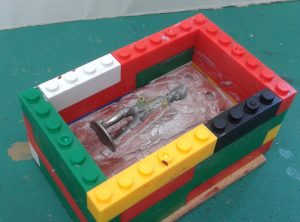
I cut the pour holes for the lead and the air vents after the two halves have cured. Being of a nervous disposition, I tend to start with the minimum amount of cutting and gradually enlarge until the castings start coming out good and usable.
From the dolly I made a rifleman (who also got a rifle, obviously) and an officer. I suspect it will provide the basic shape of some other figures as well – artilleryman perhaps or a musician.

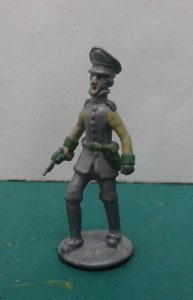
These are the final castings, with the riflemen on their rather splendid octagonal bases. Taking a bit of care when setting the figure in plasticine means there are no mould lines. All I’ve had to do with these figures is file down the fill and vent holes and snip off a little ball of lead where I stupidly allowed an air bubble to set into the silicon.
I’m quite chuffed with the results. When the hot plate arrives I aim to cast a few battalions (a battalion is eleven riflemen and an officer)……..and then all I have to do is paint them! The lead is being donated by some very generous 15mm ECW figures who, I like to think, are going up in the world.
Technical stuff
I used Silicone Mould Rubber RTV-101 which I bought from Tiranti in London. The silicone comes with a curing agent with instructions to use between 8-16 drops per 100g. I’ve always used 16 drops – I don’t know what effect using less drops would have but I assume the cure time would be proportionately longer. I’ve found that the silicone cures in around five hours at room temperature. Each half of my moulds takes 100g of silicone, so a tin of silicone should provide me with five complete moulds, at a cost of about £5.60 each.
I used plain ordinary Vaseline as a barrier to stop figures sticking to moulds and to prevent the second pouring of silicone from bonding with the first while it cures. Talc helps lead flow through the mould and makes the casting easier to remove from the mould.
Melted lead is really ‘kin’ hot. You’d think I’d have worked that out before trying to remove a newly cast figure from a mould with my fingers. So that’s the third heat issue. Wear safety goggles and heavy duty gloves………….. and use pliers to remove figures from a mould.

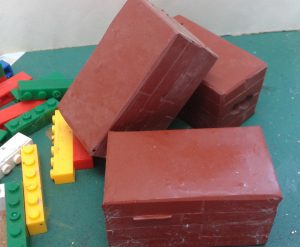
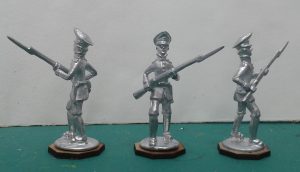
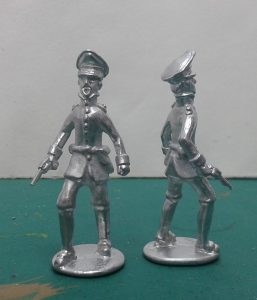
Those are brilliant! Very well done! Look forward to seeing the painted result.
Thanks Andy. You’re not doing anything silly like holding your breath are you?
Lovely figures Iain and agree with Andy about painting.
Not trying to teach you to suck eggs but you know you can use a household gas cooker ring to melt the lead…although that might not be an option for you. We used small pieces of a pencil to make the locating pins. Vaseline is also what we used to use as a separating agent but never put anything in to ensure figure release, if the mould doesn’t have any undercuts it shouldn’t be a problem. When you come to pour the ready mixed silicone and setting agent, start at one corner and let it gently flow over the figure; this helps to stop air bubbles forming. Also, if your walls and base are welded/glued/stuck together with sellotpe, gently tap each side a few times to release trapped bubbles.
Cheers Mick, that’s helpful.
I made holes in the plasticine with the end of a paintbrush to give me locating pins. After the first mould I found that by painting the mixture over the figure before pouring also avoided air bubbles. I was shocked just how much air is trapped in the silicone…..a couple of minutes of tapping away at the poured mixture still produced bubbles.
Unless the 15mm ECW figures in question were 2nd Generation Minifigs, then I would say you have found a far better use for them!
15mm Lancashire Games. Loved, but never used. They have simply been up-sized.
Awesome, well done Iain! Do you accept Paypal for when I place my order? 🙂
absolutely brilliant!! The figures look exactly how they should for this style – you are a very talented chap indeed! Love the casting step-by-step as well. These sorts of things always used to be in 1970s toy soldier books and I always want to give it a go – but as a man who managed to get superglue up his nose recently I don’t think I’d trust myself with hot lead though.
Great blog post and I can’t wait to see these guys on the table at the shiny game
You are too kind, Simon, but thank you.
My second hot plate from PA isn’t heating the lead up properly so I fear I’ll have to do as Mick suggests and use the kitchen stove……..when D is safely out of the house, obviously.